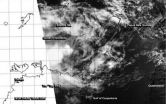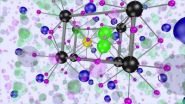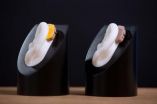(Press-News.org) NASA's Aqua satellite captured a visible image of Tropical Cyclone Gillian's remnants in the southern Arafura Sea today, as it passes north of Australia's "Top End."
During the week of March 10, Tropical Cyclone Gillian formed in the northern Gulf of Carpentaria and made a brief landfall on the Western Cape York Peninsula, weakening to a remnant low. After re-emerging in the Gulf, Gillian became a tropical storm again and by March 17 had again weakened to a remnant low as it exited the Gulf and moved into the Arafura Sea.
The MODIS or Moderate Resolution Imaging Spectroradiometer instrument aboard NASA's Aqua satellite captured a visible image of Gillian's remnants moving through the Arafura Sea, north of Top End, Northern Territory at 04:05 UTC/12:05 a.m. EDT on March 17, 2014.
According to the Joint Typhoon Warning Center, an image from NOAA's NOAA-19 polar orbiting satellite on March 17 at 02:50 UTC showed that the low-level circulation center of Gillian is ill-defined and that there is weak banding of thunderstorms around it. The system is also surrounded by dry air, which is further sapping the storm's ability to generate the thunderstorms that make up the tropical cyclone. Satellite data from the Advanced Scatterometer (ASCAT) that flies aboard the EUMETSAT METOP-A satellite showed that 10 to 15 knot/11.5 to 17.2 mph/ 18.5 to 27.7 kph winds were only seen over the western side of the storm.
On Monday, March 17. 2014, the Australian Bureau of Meteorology noted that Ex-Tropical Cyclone Gillian was located at 10 pm CST (local time, Darwin) near 10.2 south and 134.2 east, about 127.4 miles/205 km north of Maningrida and 127.4 miles/205 km east northeast of Croker Island. Gillian's remnants are moving west at 8.6 knots/9.9 mph//16 km per hour.
ABM expects Ex-Tropical Cyclone Gillian to continue moving to the west and is forecast to remain well to the north of the Top End coast. The north coast of the Northern Territory is not expected to receive gale-force winds.
Satellite data shows that rainfall and convection has been pushed to the western side of the center of circulation. Because of the wind shear, the ABM does not expect strengthening.
INFORMATION:
Text credit: Rob Gutro
NASA's Goddard Space Flight Center
NASA satellite sees Tropical Cyclone Gillian return to remnant low status
2014-03-18
ELSE PRESS RELEASES FROM THIS DATE:
Will health care reform require new population health management strategies?
2014-03-18
New Rochelle, NY, March 17, 2014–In response to the 2010 Affordable Care Act, employers may no long offer traditional employee health care benefits as they protect themselves from rising health care costs and seek to minimize their risk. How the shifting landscape of health care coverage will impact population health management providers, employers, and employees is the focus of a commentary in Population Health Management, a peer-reviewed journal from Mary Ann Liebert, Inc., publishers. The article is available free on the Population Health Management website at http://www.liebertpub.com/pop.
Bruce ...
Climatologists offer explanation for widening of Earth's tropical belt
2014-03-18
RIVERSIDE, Calif. — Recent studies have shown that the Earth's tropical belt — demarcated, roughly, by the Tropics of Cancer and Capricorn — has progressively expanded since at least the late 1970s. Several explanations for this widening have been proposed, such as radiative forcing due to greenhouse gas increase and stratospheric ozone depletion.
Now, a team of climatologists, led by researchers at the University of California, Riverside, posits that the recent widening of the tropical belt is primarily caused by multi-decadal sea surface temperature variability in the ...
Strengthening learning in children: Get outside and play
2014-03-18
University of Cincinnati researchers are reporting on the educational and health benefits of specially created outdoor play environments for children. Victoria Carr, a UC associate professor of education and director of the UC Arlitt Child and Family Research and Education Center, and Eleanor Luken, a former UC research associate for the Arlitt Center and current doctoral student at City University of New York, take a look at this growing trend around the world in an article published this month in the International Journal of Play.
Typically called playscapes, these ...
Bright future for protein nanoprobes
2014-03-18
The term a "brighter future" might be a cliché, but in the case of ultra-small probes for lighting up individual proteins, it is now most appropriate. Researchers at the U.S. Department of Energy (DOE)'s Lawrence Berkeley National Laboratory (Berkeley Lab) have discovered surprising new rules for creating ultra-bright light-emitting crystals that are less than 10 nanometers in diameter. These ultra-tiny but ultra-bright nanoprobes should be a big asset for biological imaging, especially deep-tissue optical imaging of neurons in the brain.
Working at the Molecular Foundry, ...
First guidelines for patients with pulmonary hypertension in sickle cell disease
2014-03-18
(Boston) –Boston Medical Center (BMC) and Boston University School of Medicine (BUSM) physicians have helped create the first set of clinical guidelines for treating patients with pulmonary hypertension in sickle cell disease. Elizabeth Klings, MD, director of the pulmonary hypertension inpatient and education program at BMC and associate professor of medicine at BUSM, spearheaded the development of these guidelines, which are published in the American Journal of Respiratory and Critical Care Medicine.
Several studies conducted in the past decade have demonstrated that ...
Moffitt researchers discover new mechanism allowing tumor cells to escape immune surve
2014-03-18
The immune system plays a pivotal role in targeting cancer cells for destruction. However, tumor cells are smart and have developed ways to avoid immune detection. A collaborative team of researchers at Moffitt Cancer Center recently discovered a novel mechanism that lung cancer cells use to block detection by a type of immune cell called a natural killer cell (NK cell).
NK cells find and destroy virally infected cells and also play an important role in detecting and killing tumor cells. However, tumors produce high amounts of a protein called Transforming Growth ...
Reducing anxiety with a smartphone app
2014-03-18
Playing a science-based mobile gaming app for 25 minutes can reduce anxiety in stressed individuals, according to research published in Clinical Psychological Science, a journal of the Association for Psychological Science.
The study suggests that "gamifying" a scientifically-supported intervention could offer measurable mental health and behavioral benefits for people with relatively high levels of anxiety.
"Millions of people suffering from psychological distress fail to seek or receive mental health services. A key factor here is that many evidence-based treatments ...
Only 1 fifth of people with hearing problems wear a hearing aid
2014-03-18
Just a fifth of people with hearing problems wear a hearing aid, a study by The University of Manchester has found.
The study, published in the journal Ear and Hearing, looked at the habits of 160,000 people in the UK aged 40 to 69 years. It found 10.7 per cent of adults had significant hearing problems when listening to speech in the presence of background noise - but only 2.1 per cent used a hearing aid.
One in 10 middle aged adults had substantial hearing problems and were more likely to be from a working class or ethnic minority background.
Dr Piers Dawes, from ...
Scent of the familiar: You may linger like perfume in your dog's brain
2014-03-18
An area of the canine brain associated with reward responds more strongly to the scents of familiar humans than it does to the scents of other humans, or even to those of familiar dogs.
The journal Behavioural Processes published the results of the first brain-imaging study of dogs responding to biological odors. The research was led by Gregory Berns, director of the Center for Neuropolicy at Emory University.
"It's one thing when you come home and your dog sees you and jumps on you and licks you and knows that good things are about to happen," Berns says. "In our experiment, ...
Analysis of 50 years of hit songs yields tips for advertisers
2014-03-18
Researchers from North Carolina State University have analyzed 50 years' worth of hit songs to identify key themes that marketing professionals can use to craft advertisements that will resonate with audiences.
"People are exposed to a barrage of advertisements and they often respond by tuning out those advertisements. We wanted to see what we could learn from hit songs to help advertisers break through all that clutter," says Dr. David Henard, a professor of marketing at NC State and lead author of a paper describing the research. "We also wanted to see if there were ...





